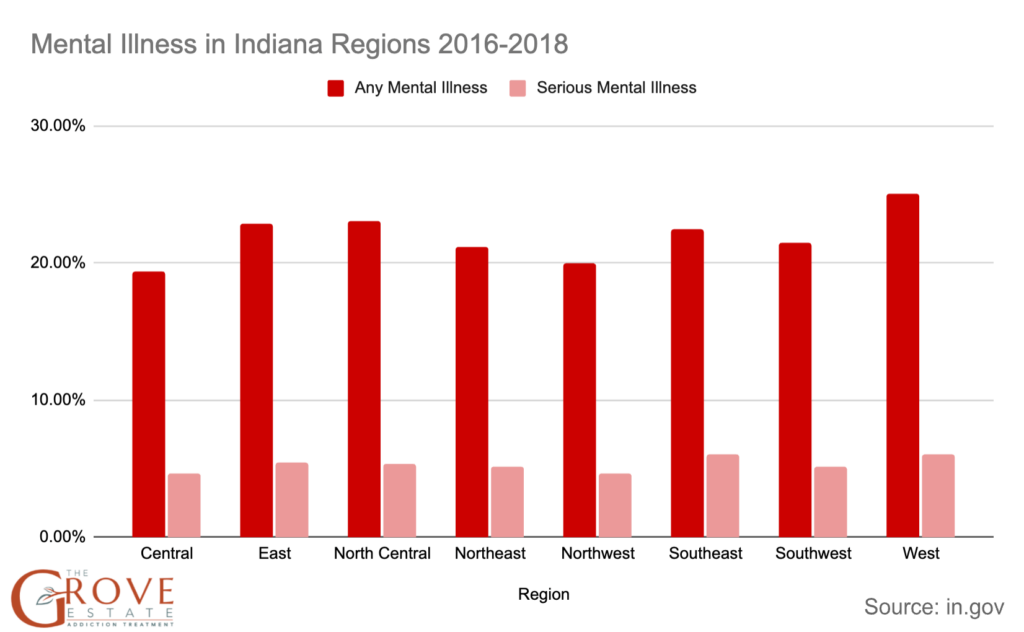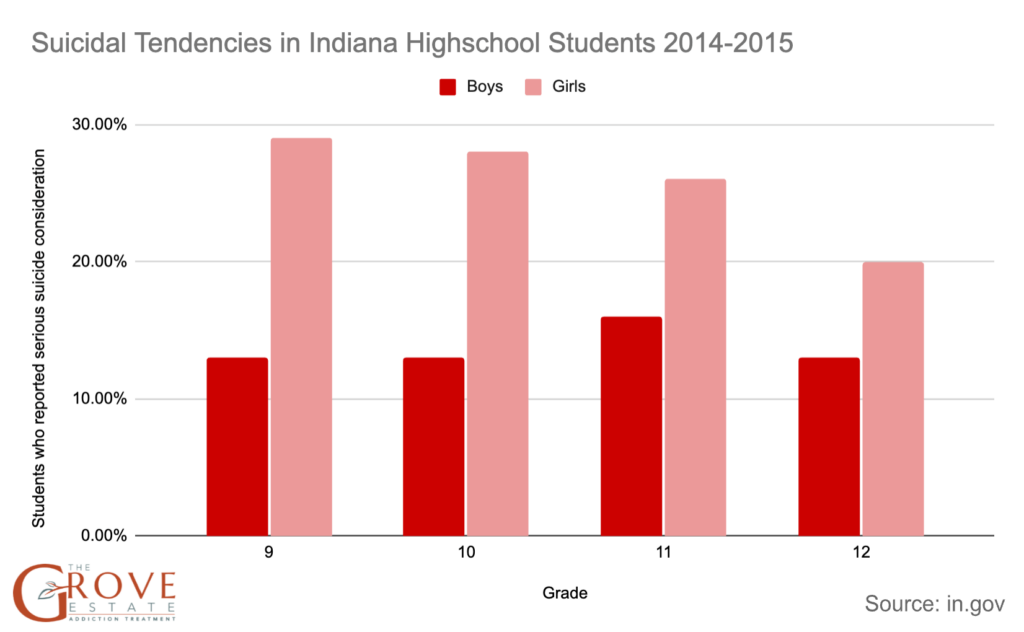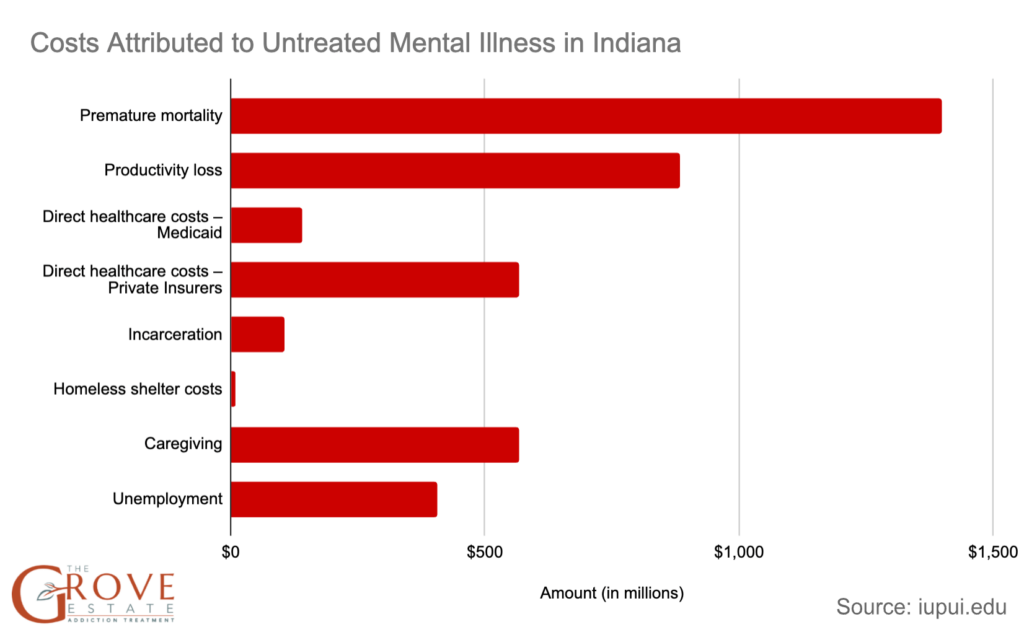While the prevalence of anxiety disorders, depressive episodes, suicide rates, and drug abuse in Indiana declined in 2021 and 2022, there has been a resurgence in 2023.
Below, we’ll look at important statistics highlighting the situation of mental health in Indiana, including numbers related to demographics, root causes, as well as the cost of bad mental health in the state.
KEY TAKEAWAYS:
- In 2023, approximately 32.9% of Indiana adults exhibited significant symptoms indicative of anxiety or depression, which stands slightly higher than the national average of 32.3%.
- As of 2021, 264,000 Indiana adults had at least one serious mental illness like schizophrenia, bipolar disorder, or major long-term depression. About 90,000 children (aged 12-17) experienced depression during the same year.
- More females (52.8%) use mental health services in Indiana as compared to males (47.2%).
- Mental health services in Indiana are predominantly used by White individuals, accounting for 76.8% of service access. African American individuals represent the next significant demographic group at 13.9%.
- Counties in Indiana with the highest rates of poor mental health include LaGrange, Starke, Newton, Jay, Delaware, Rush, Fayette, Greene, Daviess, Orange, Washington, Scott, Jefferson, Switzerland, and Crawford.
- In 2021, 1129 Indiana residents committed suicide while 2811 died by drug overdose.
- Out of the 345,000 adults in Indiana who required mental health care but did not receive it, 37.4% cited cost as the reason for not accessing it.
- The cost of untreated mental illness in Indiana is about $4.2 billion annually.
General Insights
Indiana is one of the top ten states with the worst mental health. Here are some general mental health statistics for Indiana:
- Indiana’s suicide rate has been higher than the national average since 1999.
- 1,129,000 adults in Indiana have a mental health condition. This is four times the entire population of Fort Wayne.
- Mental health issues in Indiana peaked during the COVID-19 pandemic. Here is how they’ve changed over the years:

*In this survey, the symptoms of anxiety or depression were determined based on having a score of three or more on the Patient Health Questionnaire (PHQ-2) and/or Generalized Anxiety Disorder (GAD-2) scale.
Mental Health Statistics in Indiana by Region
Here are the key mental health statistics for different regions of Indiana:
- In Indiana, every region except for the Central region has seen an increase in the percentage of adults with Any Mental Illness (AMI) over time.
- The Western region had the highest initial percentage of AMI and experienced the greatest increase (4.7%) over ten years.
- Despite starting with the lowest percentage of AMI in 2008, the Eastern region ended the year with 22.9%, surpassing the state average of 21.59%.
- The Midwest had the highest prevalence of serious mental illness (SMI), slightly higher than the national average of 4.13%.

Adolescent Mental Health Statistics in Indiana
The following are some key mental health statistics concerning the adolescents of Indiana:
- Approximately 28% of adolescents aged 12-17 in Indiana experience mental, emotional, developmental, or behavioral issues based on data from the National Survey of Children’s Health (2017-2018).
- About 10% of Indiana high school students attempted suicide one or more times during 2014-2015. By 2020, the percentage rose to 11.98% (one in nine sixth-grade students) and 19.3% (one in five tenth-grade students).
- Among students who reported serious suicide consideration, ninth-grade girls had the highest percentage at 29%, followed by girls in grades 10, 11, and 12. In comparison, boys of the same age had significantly lower suicidal tendencies.

- By 2021, Indiana’s adolescent suicide rate was about 11-12 children out of every 100,000. This ranks Indiana 20 out of the 50 states in suicide control.
- 35% of Indiana high school students have used marijuana at least once and the 12.1% monthly use of marijuana by grade 10 students remained consistent from 2016 – 2018. After 2018, there was a significant increase in the use of other types of drugs including ecstasy, cocaine, and methamphetamines.
- According to the National Survey of Children’s Health (2017-2018), only a fraction of children aged 3-17 with mental or behavioral conditions receive counseling.
- Major depressive disorders led to hospitalizations for around 32 out of every 10,000 adolescents aged 10-17 in Indiana. Bipolar disorders led to hospitalizations for 13 out of every 10,000 adolescents.
- A significant proportion of refugees aged 13-21 in Indiana screened positive for mental health issues between 2017 and 2019.
- In 2022, 35.7% of Indiana youngsters felt so sad or hopeless for two or more weeks that they stopped doing their usual activities. This is a seven percent increase from 2016.
Causes of Mental Health Issues in Indiana
The leading causes of mental health issues in Indiana include poverty, homelessness, little or no access to mental health care, and substance abuse. Here are some numbers related to these issues:
- 5,625 people in Indiana are homeless. This is one of the causes of major mental health issues in Indiana.
- Nearly 36% of Black children, compared with 33% of Hispanic and 12% of White children, live in poverty in Indiana.
- Children living in extreme poverty (below 50% poverty) consist of 18% of Black children, 14% of Hispanic children, and 5% of White children.
- People who are poor in their early years are more than twice as likely to suffer from poor overall health and elevated stress levels as adults compared to those who do not experience childhood poverty.
- Drug overdose death rates in Indiana rose from 15.3 per 100,000 in 2011 to 43 per 100,000 in 2021. During the same timeframe, drug overdose death rates in the U.S. increased from 13.2 to 32.4 per 100,000.
Mental Health Costs in Indiana
Poor mental health has economic consequences. Here are some important statistics:
- One out of every five Indiana residents with mental illness does not receive the necessary treatment. These individuals are more likely to experience other chronic health conditions like diabetes and cardiovascular disease, burdening the state’s healthcare system.
- The estimated loss per person due to mental health issues is $600 in Indiana, equating to $1600 per family.
- The largest cost attributed to untreated mental illness is premature mortality, which is about $1.4 billion per year. This is followed by productivity losses, amounting to $885 million each year.

- The average annual per capita cost of operating Indiana’s mental hospitals in 1940 was about $198.57. This figure had significantly reduced to $104.83 in 2012.
Mental Health Care and Facilities in Indiana
Statistics related to mental health facilities in Indiana include:
- The most prominent mental health care facilities in Indiana are:
- Logansport State Hospital (1888-present): Admitted 38,498 patients as of June 2008.
- Madison State Hospital (1910-present): Admitted 47,106 patients as of June 2008.
- A total of 4,426,818 individuals in Indiana reside in areas lacking sufficient mental health professionals. However, the ratio of Indiana residents to mental health practitioners has declined across all regions in Indiana over the years, resulting in improved access to mental health treatment.
| Population: Mental Health Practitioner Ratio | |||
| Region | 2011 – 2012 | 2016 | 2020 |
| Indiana | 3861:1 | 735:1 | 594:1 |
| Rural | 8337:1 | 1066:1 | 876:1 |
| Metro | 3200:1 | 673:1 | 544:1 |
Where Does Indiana Rank in Mental Health?
According to the State of Mental Health in America 2023, Indiana ranks 41st in terms of mental health. This is an improvement from 2022 when Indiana ranked 43rd out of the 50 states.
How Much Does Indiana Spend on Mental Health?
According to a survey conducted in 2019, Indiana spends $708.5 million in direct healthcare costs and loses $3.3 billion in indirect costs. The total annual societal cost of prevalent mental health issues is about $4.2 billion.
What Demographic Has the Highest Mental Distress Rate in Indiana?
Indiana ranks 27 for mental health distress amongst men and 41 for women. This indicates women have higher mental distress rates in Indiana as compared to men.
In addition, the state ranks 42nd for White people, 21st for Black people, 18th for Multiracial, and eighth for Hispanic. A higher rank is indicative of greater mental distress, suggesting White people experience the highest mental distress in Indiana.
How does social media use affect mental health?
Social media has a complex relationship with mental health, influencing users’ mood, self-esteem, and feelings of connection. According to “Social Media Addiction & Usage Statistics,” excessive use can lead to negative outcomes such as feelings of inadequacy, anxiety, and depression.
What is the current state of drug abuse and addiction in Indiana?
According to the latest “Drug Abuse & Addiction Statistics in Indiana,” the state faces significant challenges with substance abuse, including opioids, methamphetamine, and alcohol. These statistics reveal trends and demographics most affected by addiction, helping to tailor prevention and treatment efforts.
What is the impact of economic downturns on mental health in Indiana?
Economic downturns can significantly exacerbate mental health issues, leading to increased rates of stress, anxiety, and depression. In Indiana, these conditions often spike during periods of high unemployment or economic instability. For instance, professionals in high-stress jobs may experience more intense pressure during economic downturns, potentially increasing their risk for mental health disorders. For more information on how specific professions are affected, see professions with highest addiction rates.
Additionally, economic challenges can make it difficult for individuals to afford necessary healthcare, including mental health services. In Indiana, where economic fluctuations are common, the demand for affordable mental health services increases during downturns. This situation underscores the importance of accessible healthcare options, such as residential detox, which can provide critical support during these challenging times.
Data Sources:
- https://www.kff.org/other/state-indicator/adults-reporting-symptoms-of-anxiety-or-depressive-disorder-during-covid-19-pandemic/
- https://www.nami.org/NAMI/media/NAMI-Media/StateFactSheets/IndianaStateFactSheet.pdf
- https://www.in.gov/fssa/dmha/files/Regional-MH-and-Suicide-Trends-in-Indiana.pdf
- https://www.cdc.gov/nchs/pressroom/sosmap/drug_poisoning_mortality/drug_poisoning.htm
- https://www.cdc.gov/nchs/pressroom/sosmap/suicide-mortality/suicide.htm
- https://news.iu.edu/live/news/31940-untreated-mental-illness-costs-indiana-over-4
- https://www.in.gov/health/mch/files/adolescent-health-fact-sheet.pdf
- https://www.in.gov/issp/about-suicide-prevention/
- https://digirepo.nlm.nih.gov/ext/dw/43030200R/PDF/43030200R.pdf
- https://www.indianaprevention.org/youth-suicide-statistics
- https://www.americashealthrankings.org/explore/measures/teen_suicide/IN
- https://iprc.iu.edu/main/GIS-in-prevention-Mental-Health.php
- https://www.nasmhpd.org/sites/default/files/Assessment%2010%20-%20Expenditures_0.pdf
- https://www.in.gov/fssa/dmha/files/Regional-MH-and-Suicide-Trends-in-Indiana.pdf
- https://mhanational.org/issues/2023/ranking-states
- https://mhanational.org/issues/2022/ranking-states
- https://www.ncbi.nlm.nih.gov/pmc/articles/PMC10576212/
- https://www.americashealthrankings.org/explore/measures/mental_distress/IN?population=mental_distress_Multiracial_C

Share This Post



